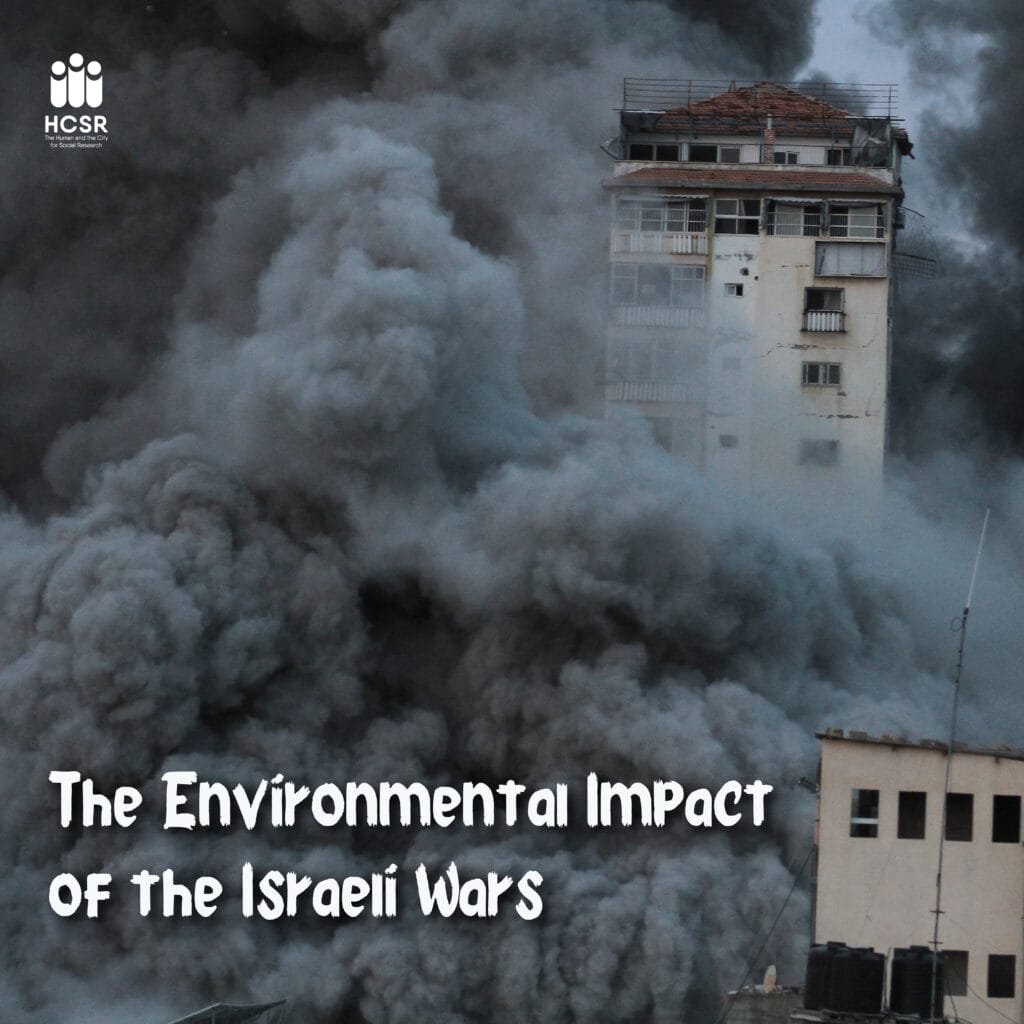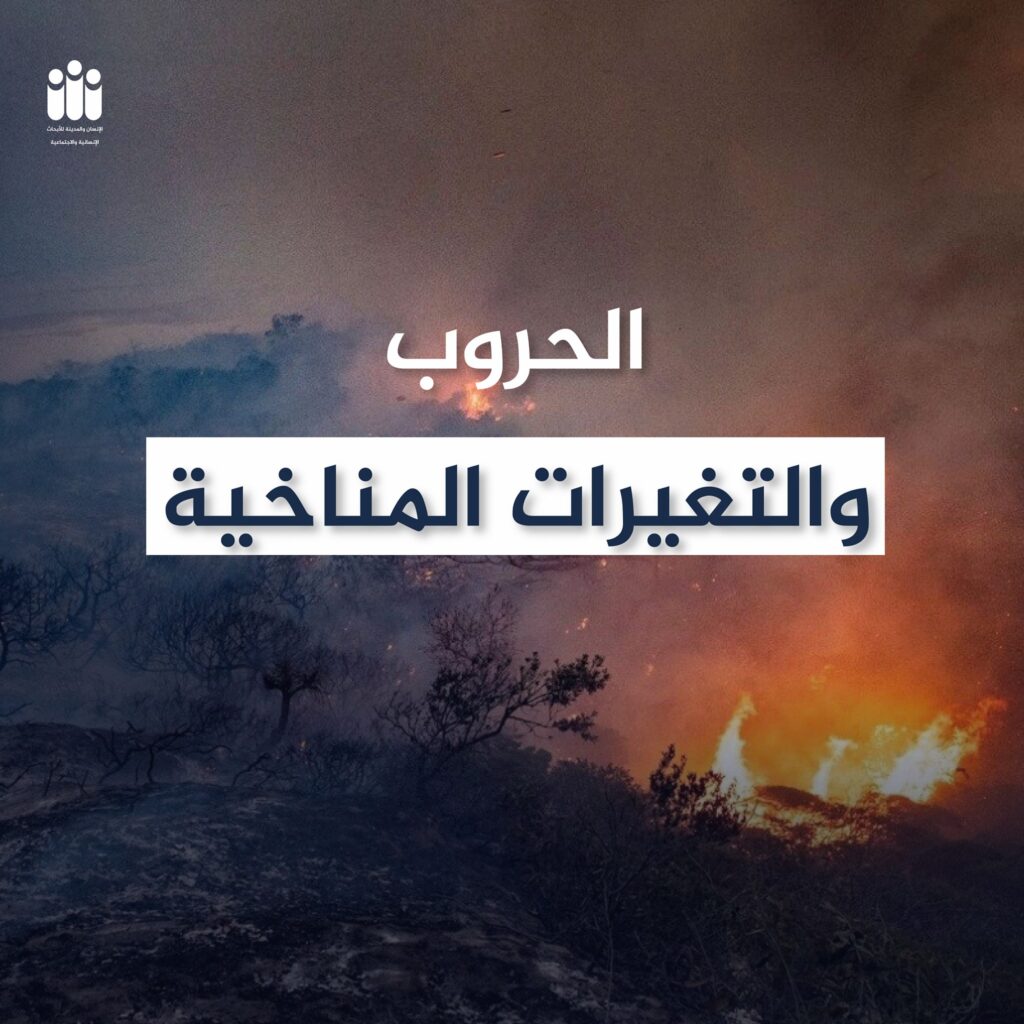The Environmental Impact of the Israeli Wars

A whole year of environmental destruction in the region renders any environmental talks or campaigns mere nonsense. The significant and ongoing environmental damages of what the occupying entity has been doing in Gaza for the past 12 months, and what it is currently doing in Lebanon, could reach the entire planet and the region in particular, akin to what fossil fuels and plastic could do for years. These result in catastrophic effects on the region as a whole, as well as on the ecosystems of the Mediterranean, and vital infrastructure, directly threatening the health and lives of the people of Gaza and Lebanon. The Israeli army observes the “scorched earth policy” to destroy what it cannot occupy, including land, crops, natural resources, and infrastructure, notwithstanding the environmental impact that extends to the areas it controls, and expands to encompass the entire region. Land: 1- Military operations have led to soil contamination with heavy metals such as lead and mercury, along with toxic chemicals, causing soil infertility and chronic diseases including cancer. 2- Military operations in Gaza have destroyed over 42% of agricultural and arable lands in Gaza, with the United Nations estimating losses from these damages at nearly 629 million USD until June 2024. 3- Military operations have destroyed nearly 90% of olive tree agricultural lands in various areas of the Gaza Strip, depriving the people of Gaza of olive harvesting for the second consecutive year. Olive trees take at least five years to bear fruit. The destruction of olive trees affects the environmental balance, increases desertification, and negatively impacts biodiversity, not to mention the economic aspect and the population’s reliance on the crop. 4- The Israeli crimes have turned Gaza’s land into dangerously polluted land, affecting health and destroying the food security of the area, thus its dependence on food aid post-war for long decades, indicating that the war of starvation continues even after the war of arms. Additionally, all what is happening to Gaza’s land has a direct impact on the environmental balance of the region, including lands under the Israeli control. Water: 57% of water facilities, including desalination plants, wells, and water networks, have been destroyed, leading to a severe water shortage. Over 162 wells have been destroyed, in addition to the 3 main water desalination plants in Gaza, resulting in a loss of 95% of the water production capacity in Gaza Strip and estimated losses of 503 million USD. Groundwater contamination with heavy metals and chemicals resulting from military operations renders 97% of water in Gaza undrinkable for humans, animals, or irrigation. According to the World Health Organization, nitrate levels are 6 times higher than the permissible limit. Cases of waterborne diseases, such as diarrhea and hepatitis, have indeed increased due to water pollution. Pollution from sewage water and chemicals leads to groundwater contamination. The collapse of sewage treatment networks has led to the discharge of 60,000 cubic meters of untreated water daily into the Mediterranean Sea, causing pollution and destruction of marine habitats. Estimates indicate that 25% of the sea water near Gaza has become contaminated with harmful bacteria and heavy metals. Pollution can be carried through marine currents to neighboring countries in the Mediterranean Sea, such as Egypt, Lebanon, Turkey, and Greece, threatening water quality and fish resources in these countries. Moreover, Israel heavily relies on sea water desalination plants that it pollutes, endangering everyone’s lives. Air Pollution: 1- Continuous bombing, explosions, and airborne dust from the rubble have led to the release of thousands of tons of fine particles and chemicals into the air, including sulfur dioxide, nitrogen oxides, and toxic particles such as asbestos. 2- The number of fires due to the aggression from October 2023 to only January 2024 reached 165 fires, including 19 in industrial areas, resulting in air pollution with toxic chemicals. 3- This pollution poses a significant risk to the respiratory health of the population, especially with continued inhalation of fine particles. Hospitals have witnessed a 300% increase in respiratory diseases and asthma cases during the first three months of the aggression alone, affecting over 179,000 individuals, including children and the elderly. 4- The total rubble generated by military attacks has exceeded 39.2 million tons, equivalent to over 10 pyramids of Giza. This quantity also covers more than 365 square kilometers, the total area of Gaza, with a height exceeding one meter of rubble, which is 13 times more than the total rubble resulting from all previous wars since 2008. The rubble contains hazardous materials including over 800,000 tons of potential asbestos and unexploded ordnance (UXOs). Airborne dust poses a respiratory hazard, especially with the presence of toxic substances. These materials will continue to pose a health risk to the population for decades to come. 5- Approximately 1,100 to 1,200 tons of waste accumulate daily in the affected areas, including 400 tons daily in displacement sites alone. Over 1.5 tons of contaminated medical waste are left untreated every day in hospitals, increasing the risk of spreading infectious diseases and hazardous chemicals. With waste transportation issues unresolved, residents resort to burning waste outdoors, further complicating the issue of air pollution. 6- Air pollution spreads to neighboring countries with the wind, including territories under Israeli occupation in the West Bank, Egypt, Jordan, Lebanon, Syria, Turkey, and Greece. 7- Toxic gases emissions and fine particles resulting from destruction may contribute to rising temperatures, and exacerbate the effects of climate change in the Mediterranean region, contributing to global climate change. It is worth mentioning that the above information is the latest recorded data, not to mention the damages that are yet undocumented, or the updated damages caused by the failure of the international community to stop the year-long ongoing genocide. The environmental impact of the war on Gaza requires a rapid and comprehensive intervention to protect the population and the environment in the short and long term. The international community has to take urgent measures to provide support and assistance in rebuilding the environmental infrastructure and enhancing the protection of natural
Must Know about COP

In November, Egypt hosts the twenty-seventh Conference of Parties (COP 27) in Sharm El-Sheikh. In light of this and our coverage of this international mega event, believing in the importance of community awareness, we start with the most important definitions: What is COP? The Conference of Parties is the decision-making body responsible for monitoring and reviewing the implementation of the United Nations Framework Convention on Climate Change (UNFCCC). Who are the parties? They are the 197 countries and territories that have signed the framework agreement, including Egypt. When is the conference held and what are its most important achievements? COP has been held annually since its first edition in 1995. Perhaps its most important achievement is the unification of countries in the first international climate agreement to reduce the risks of climate change. Kyoto Protocol: About Kyoto Protocol Date: 1997 Number of signatories: 195 countries Goals: to reduce the emission of 6 specific gases: carbon dioxide, methane, nitrogen oxide, in addition to three fluorescent compounds, by 5.2%, compared to 1990. Role: It places the responsibility for implementing the brunt of the commitments on the shoulders of the developed countries, as the protocol obligates them to provide all forms of financial and technical support to help developing countries implement the obligations arising from common international policies to protect the environment from pollution. Paris Agreement The Paris Climate Agreement is an output of the COP 21 held in the French Capital in 2015. Based on the Kyoto Protocol, it was effectuated in November 2016. About The Paris Agreement: Date: December 2015 Number of signatories: 194 Objectives: – Addressing the problem of greenhouse gas emissions and finding ways to adapt to it – Paying serious attention to the effects of climate change – Limiting temperature rise to less than two degrees Celsius Most important terms: – Reducing the intensity of greenhouse gas emissions by reducing energy consumption, investing in clean energies and reforestation. – Strengthening efforts to limit the temperature increase to 1.5 degrees Celsius Role: The agreement commits rich countries to provide 100 billion USD annually starting in 2020 to developing countries for helping them finance renewable energies. What is IPPC? Conventional energy vs Renewable energy In light of the global energy crisis, rising prices and the planet’s suffering from climate change, attention is turning towards renewable energy. Is clean energy the world’s only hope for a better future?To answer this question, we will review the most important benefits of each of the two energies and their limitations.
Impact of War on Climate Change

Since the dawn of history, war have been part of the human experience. When we think of war, scenes of bloodshed, hideous corpses, demolition of homes, dismantling families and leaving homelands come to mind. The environment is one of the unknown and silent victims of wars. Habitat destruction may ruin the ecological system at large, encompassing air pollution, land degradation, biodiversity loss, harm to marine life. These impacts may extend to tens of years affecting human lives as well as contributing to climate change. At a time when scientists, thinkers and various concerned authorities dealing with climate changes struggle to maintain normal temperature rates and work to stop its rise, we see new wars added to the list, such as the conflict between Russia and Ukraine, whose consequences are expected to be catastrophic on climate changes due to the energy crisis it generates. The United States, Saudi Arabia and Russia are among the top three countries in the fuel trade, and Russia is the first source of natural gas to Europe. Due to the ongoing conflict between Russia and the West, European energy security is under threat from Putin. The Russian president refused to accept the cost of natural gas either in US dollars or in Euros, and insisted on receiving in his country’s currency, the Russian ruble. The United States and Europe have begun stockpiling their coal as a precaution in case Russia refuses to sell them natural gas or decides to stop providing financial support to ease the pressure of the war on Ukraine. Germany and some neighboring countries have already temporarily returned to relying on coal until the crisis is resolved or alternative sources of natural gas are found. The problem lies in not knowing the actual length of this temporary period, as it may extend to several years. It is also expected that this will not only be limited to Germany and some neighboring countries, but will include all of Europe, after they were on the path of the complete banning of the use of coal by 2038[1]. The situation was further complicated by the sabotage actions against the two gas pipelines: “Nord Stream 1” which started its work in 2011 and is able to transport 170 million cubic meters per day of gas, and “Nord Stream 2” which was supposed to transport 55 billion cubic meters of gas but was discontinued by Germany in response to the Russian war on Ukraine[2]. Given the damage to the two gas lines, it is expected that repairs will not be completed before six months at best, which confirms the fact that the upcoming European winter will be the most difficult with high gas prices and scarcity, and consequently high prices of electricity needed for heating, which brings us back to the use of wood as a heating source; thus, logging huge numbers of trees for this purpose. The problem of returning to coal use is not only in extraction, manufacturing, transportation or trade, but rather lies in the process of its combustion. It is the largest contributor to the increase in carbon dioxide in the atmosphere. Coal-fired electricity generation produces nearly twice as much greenhouse gases per kilowatt as compared to natural gas generation[3]. If this shift in energy sources occurs, it will jeopardize attempts to maintain global warming (by only 1.5°C) and existing efforts to try to reduce carbon dioxide concentrations (to 350ppm) at serious risk. During wars and armed attacks, green spaces are destroyed or burnt; this leads to a rise in carbon dioxide in the atmosphere, in addition to destroying the natural habitats of animals, birds and other living creatures that use forests and green spaces as their environment. As green spaces are destroyed, it becomes more and more difficult to get rid of carbon dioxide and it remains in the atmosphere for a longer time. Militaries consume huge amounts of fossil fuels, which directly contribute to global warming. For example, if the US army were a country, it would have ranked 48th in terms of total emissions around the world[4]. As most countries invest more money in their armies, the use of fossil fuels is rising, with or without conflict. And while the military (even without engaging in wars) contributes to climate change, active warfare increases this contribution exponentially. For example, the United States and allied forces have launched more than 337,000 bombs and missiles at other countries over the past 20 years[5]. Airplanes used to load and transport these weapons burn about 16 liters of gasoline per kilometer[6]. With the explosion of each bomb, the percentage of carbon dioxide in the atmosphere increases, in addition to destroying the soil and green spaces, which are among the most important sinks of carbon dioxide. The so-called US war on terrorism has produced 1.2 billion metric tons of greenhouse gases in the atmosphere, with more global warming effects than the annual emissions of 257 million cars[7]. Drinking water infrastructure is severely damaged during wars, which affects the availability of water, as is the case in Syria after 10 years of war[9], in addition to the pollution of water bodies adjacent to military camps resulting from the dumping of waste of all kinds, the most dangerous of which is the fuel waste or chemicals used in the maintenance of warships[10]. In addition to nuclear and hydrogen bombs weapons tests conducted by countries such as the USA, Russia and North Korea[11], which can lead to several negative effects such as soil and groundwater pollution, and marine pollution with chemicals and minerals that may include mercury, iron and plutonium. This could also have severe consequences for plants and marine organisms in these areas, leading to disruptions in the food chain[12]. The health and safety of natural resources, now and in the future, is one of the most important sustainable development goals in light of the climate changes, which affect soil fertility as a result of drought resulting from high temperatures and their negative impact on the cultivation of crops in various


